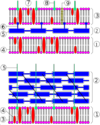Bacterial Structure
Jump to navigation
Jump to search
Bacterial genome:
- Contains double-stranded DNA
- Prokaryotic DNA differs to eukaryotic DNA:
- Few repeated sequences
- Most of the DNA is transcribed
- No intervening sequences within structural genes
Cytoplasm:
- Does not contain mitochondria, lysosomes or Golgi bodies (found in eukaryotic cells)
- Contains mesosomes- thought to be primitive endoplasmic reticulum
Surface components:
- Fimbriae- also known as pili, these are hair-like structures that allow bacteria to adhere to each other
- F-type pili- also known as sex pili, these act as conjugation tubes during sexual reproduction
- Capsules/slime- serve to adhere bacteria to cells and provide protection from phagocytosis and dehydration, e.g. hyaluronic acid
- Flagella- help the bacteria move around
One way bacteria can be classified is by the structure of the cell wall:
- Gram-positive bacteria: cell wall consists of peptidoglycan layer, with teichoic polymers attached, e.g. Staphylococcus
- Gram-negative bacteria:peptidoglycan layer is thinner, but surrounded by outer membrane of lipopolysaccharides and lipoproteins, e.g. salmonella
| Component | Gram positive | Gram negative |
|---|---|---|
| Peptidoglycan | Yes | Yes |
| Teichoic acid | Yes | No |
| Lipoprotein | No | Yes |
| Lipopolysaccharide | No | Yes |
| Phospholipid | No | Yes |
Another method of classification is the shape and arrangement of the bacteria themselves:


